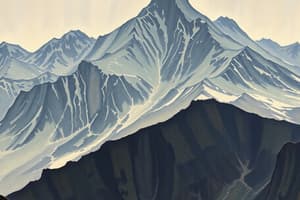Podcast
Questions and Answers
What geological feature is formed at a convergent boundary between oceanic and continental crust?
What geological feature is formed at a convergent boundary between oceanic and continental crust?
- Mid-ocean ridge
- Mountain range
- Rift valley
- Volcanic arc (correct)
Which of the following correctly describes subduction?
Which of the following correctly describes subduction?
- The diving of a denser plate beneath a less dense plate (correct)
- The separation of tectonic plates leading to rift formation
- The lateral sliding of plates past each other
- The process where two continental plates collide and uplift
Under what conditions would a mountain range typically form?
Under what conditions would a mountain range typically form?
- At continental-continental convergent boundaries (correct)
- At divergent boundaries
- At transform boundaries
- At oceanic-oceanic convergent boundaries
Which type of boundary is primarily associated with seafloor spreading?
Which type of boundary is primarily associated with seafloor spreading?
What geological activity is most likely to occur at a transform boundary?
What geological activity is most likely to occur at a transform boundary?
Flashcards are hidden until you start studying
Study Notes
Plate Boundaries
- Divergent Boundary: Plates move apart; examples include continental-continental rifts (forming rift valleys) and oceanic-oceanic mid-ocean ridges (resulting in seafloor spreading).
- Convergent Boundary: Plates collide; types include:
- Continental-oceanic: denser oceanic plate subducts beneath continental plate, forming a trench and a continental volcanic arc.
- Oceanic-oceanic: one oceanic plate subducts under another, creating a volcanic island arc and a trench.
- Continental-continental: both plates buckle and uplift, forming mountain ranges.
- Transform Boundary: Plates slide past each other horizontally, often resulting in faults and earthquakes.
Mechanisms of Plate Movement
- The text does not specify the mechanisms causing plate movement.
Evidence of Plate Movement
- The text does not specify the evidence for plate movement.
Studying That Suits You
Use AI to generate personalized quizzes and flashcards to suit your learning preferences.




